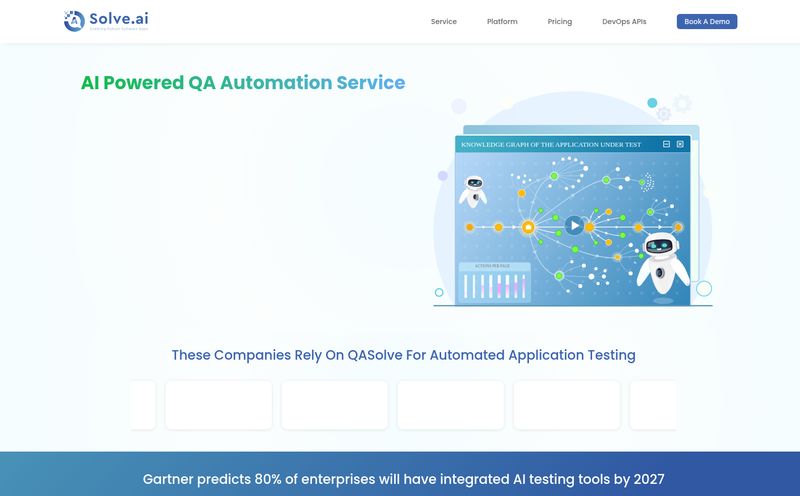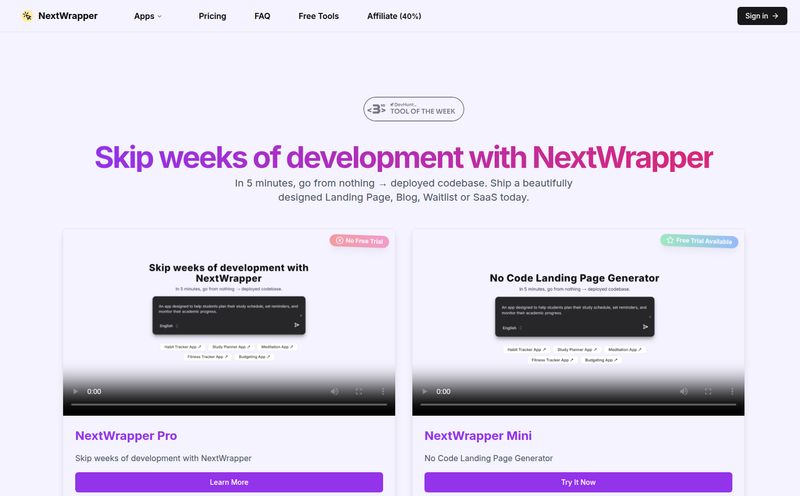If you're in the SEO or digital agency world, you know the grind. That initial phase of any new website project can be an absolute slog. The endless back-and-forth on sitemaps, the soul-crushing blank page of a wireframe, trying to squeeze brand-approved content out of a client who thinks a 'mission statement' is a single sentence. It’s the digital equivalent of trying to build a house with a handful of wet spaghetti. Fun times.
So, whenever a new tool pops up promising to automate that misery, my ears perk up. But let's be honest, most of them are… underwhelming. They’re clunky, spit out generic garbage, and you end up spending more time fixing their mistakes than you would’ve just doing it yourself. But every now and then, something comes along that makes you lean in a little closer. This week, for me, that something was SiteForge.

Visit SiteForge
So, What Exactly is SiteForge?
On the surface, SiteForge calls itself an AI website generator. But that’s a bit like calling a smartphone a “pocket calculator.” It doesn’t quite capture the whole picture. I'd describe it more as an AI-powered pre-production assistant for your web projects. It’s designed to tackle the most time-consuming, brain-draining parts of getting a site off the ground: planning the structure (sitemap), laying out the bones (wireframe), and generating the initial meat (content).
It’s aimed squarely at folks like us: digital agencies juggling multiple clients, marketing teams under pressure, and small business owners who don’t have a 20-person creative department on standby. The whole idea is to get you from “new client kickoff” to “ready for development” in a fraction of the time. A bold claim, for sure.
Kicking the Tires on AI-Powered Web Design
I decided to take it for a spin on a hypothetical project—a local, eco-friendly coffee shop. This is a classic small business client, the kind that needs a solid online presence but has zero time or expertise.
The AI Sitemap Generator: Your Digital Architect
First up was the AI Sitemap Generator. I fed it the basic concept: “Cozy, eco-conscious coffee shop in Austin, Texas, serving locally sourced coffee and pastries, with a small event space.” And I waited. The output was… surprisingly good. It didn’t just give me a generic Home, About, Contact. It suggested pages like 'Our Sourcing Story', 'Community Events', 'Menu', a 'Blog' with ideas like 'The Perfect Pour: A Home Brewing Guide,' and a 'Catering Inquiry' page.
This is the stuff that usually takes a 45-minute brainstorming session. Having a logical, SEO-friendly structure generated in seconds? That’s not just a time-saver; it’s a fantastic starting point for a client strategy call. You look instantly prepared.
From Sitemap to Structure with the AI Wireframe Generator
Next, the AI Wireframe Generator. This is where I was most skeptical. AI making visual layout decisions often ends in chaos. But SiteForge took the sitemap it just created and generated a clean, logical wireframe for each page. It wasn't a finished design, mind you—no colors, no fonts, just gray boxes and lorem ipsum. But it was a structurally sound wireframe. It placed a hero section, followed by a three-column feature block on the homepage, a proper menu layout, and a footer with all the right elements. It even created a decent layout for the blog page.
The best part? No templates. It claims to generate custom layouts each time. It felt less like picking a theme and more like having a junior designer quickly sketch out a solid, if uninspired, first draft. And frankly, a solid first draft in 60 seconds is worth its weight in gold.
The Content Conundrum and the AI Copilot
Ah, content. The bane of every project manager’s existence. SiteForge’s answer is its “AI Content Copilot” and drag-and-drop content blocks. This is where the magic (and the necessary caution) comes in. You can feed the AI your brand’s voice—in my case, “friendly, a bit witty, passionate about sustainability”—and it populates those wireframe boxes with actual copy.
The copy for my coffee shop was… pretty decent! It wasn’t Shakespeare, but it was better than 90% of the first-draft client copy I’ve ever received. It captured the “cozy, eco-friendly” vibe without sounding like a robot wrote it. I can see this being an absolute game-changer for scaling content. Imagine building out 30 service pages for a client. Instead of starting from scratch on each one, you have a solid, on-brand foundation to edit and refine. Thats a huge win.
Let's Talk SEO: Does It Pass the Sniff Test?
As an SEO, this is where the rubber meets the road for me. A pretty site that cant rank is just a pretty digital paperweight. SiteForge says it has “SEO Optimization” baked in. From what I could see, this primarily relates to creating a logical site structure (a huge and often overlooked part of SEO) and generating relevant page topics. The AI-generated blog ideas were also a nice touch for topical authority building.
However, you have to be realistic. This tool isn't going to do your keyword research for you or build your backlinks. It provides a foundation for good SEO. It’s up to you, the expert, to take that foundation and build a skyscraper on it. Think of it as an assistant that preps all your ingredients perfectly—you still have to be the chef who cooks the meal.
The Good, The Bad, and The "Coming Soon"
No tool is perfect. After playing around for a while, here's my honest breakdown.
What I Really Liked
The speed is just... wow. The ability to go from an idea to a fully fleshed-out sitemap, wireframe, and initial content draft in minutes is incredible. It systemizes the messy, creative part of the process. For agencies, this means you can scale your operations without necessarily scaling your headcount at the same rate. Maintaining brand messaging across dozens of pages becomes trivial, not a week-long copy-editing nightmare. The fact that it generates custom layouts instead of relying on tired templates is a major plus in my book.
A Few Caveats to Consider
First, and this is a big one, you cannot blindly trust the AI. You must have a human in the loop. The AI content is a great start, but it needs a human eye for nuance, fact-checking, and that final spark of creativity. Second, there's a bit of a learning curve. To get the most out of it, you need to learn how to write effective prompts and guide the AI. It's not a one-click-and-done solution. Finally, some of its most intriguing features, like AI Branded Generations and Ad Generation, are still listed as “coming soon.” That's exciting, but also means you're buying into a platform that's still evolving.
What's the Damage? A Look at SiteForge Pricing
This is the million-dollar question, isn't it? As of this writing, I couldn't find a public pricing page. This isn't uncommon for new tools in the SaaS space, especially those targeting agencies, as they might be testing different price points or offering custom plans. My best advice is to head directly to their website and see what the current options are. It might be a demo-request situation, so be prepared to chat with their team.
Is SiteForge Worth It For Your Business?
So, the final verdict. Who is this for?
In my opinion, SiteForge could be a massive force multiplier for digital agencies and marketing teams. If your workflow involves repeatedly building new websites or large landing page campaigns, the time saved on the initial setup phase could be enormous, freeing up your team to focus on higher-level strategy, creative work, and client relationships. For small business owners who are comfortable with tech but lack design or content resources, this could be the bridge that gets them a professional-looking and well-structured site without the hefty agency price tag.
Who is it not for? If you're a large enterprise with a deeply entrenched, multi-departmental web development process, this might be too lightweight. Likewise, if you're a hobbyist just building one simple blog, the full suite of features might be overkill.
Final Thoughts
I came into this review with a healthy dose of skepticism, and I'm leaving… cautiously optimistic. SiteForge isn't a magic wand that builds a perfect, client-ready website with one click. It’s a powerful, intelligent assistant that handles the grunt work. It sets the stage, organizes the props, and hands you a script. You still have to direct the play. And for anyone who's ever stared at a blank screen on a Monday morning, that's a pretty compelling proposition.
Frequently Asked Questions about SiteForge
- 1. What is SiteForge in simple terms?
- Think of it as an AI assistant that helps you plan and start building a website. It automatically creates a site map (the list of pages), a wireframe (the basic page layout), and writes the first draft of your content, all based on a simple description you provide.
- 2. Who is the ideal user for SiteForge?
- It's best for digital agencies, marketing teams, and small business owners who need to create well-structured websites efficiently but might not have a big design or content team. It's built for scaling and speed.
- 3. Does SiteForge replace a web developer or designer?
- No. SiteForge handles the initial planning and content stages. It gives you a structured wireframe and copy, but you'll still need a developer to build the final, functional website and a designer to apply branding, colors, and polish to the layout.
- 4. Is the content generated by SiteForge unique and SEO-friendly?
- The content is generated on-demand and is original in that sense, but it should always be reviewed and edited by a human. Its SEO-friendliness comes from creating a good site structure and relevant on-page topics, which is a great starting point for a full SEO strategy.
- 5. Do I need technical skills to use SiteForge?
- You don't need to be a coder, but some understanding of website structure (what a sitemap and wireframe are) is helpful. The main skill is learning to write clear instructions (prompts) for the AI to get the best results.
- 6. How does SiteForge handle brand consistency?
- One of its key features is the ability to feed it your brand's specific tone of voice. This guides the AI Content Copilot to generate copy that aligns with your brand messaging, which is a huge help when creating many pages at once.
Reference and Sources
Information for this review was based on publicly available feature descriptions for SiteForge.
For more on the role of AI in SEO, Moz offers excellent resources on the topic. You can read more here: Moz Blog on AI & Machine Learning.



